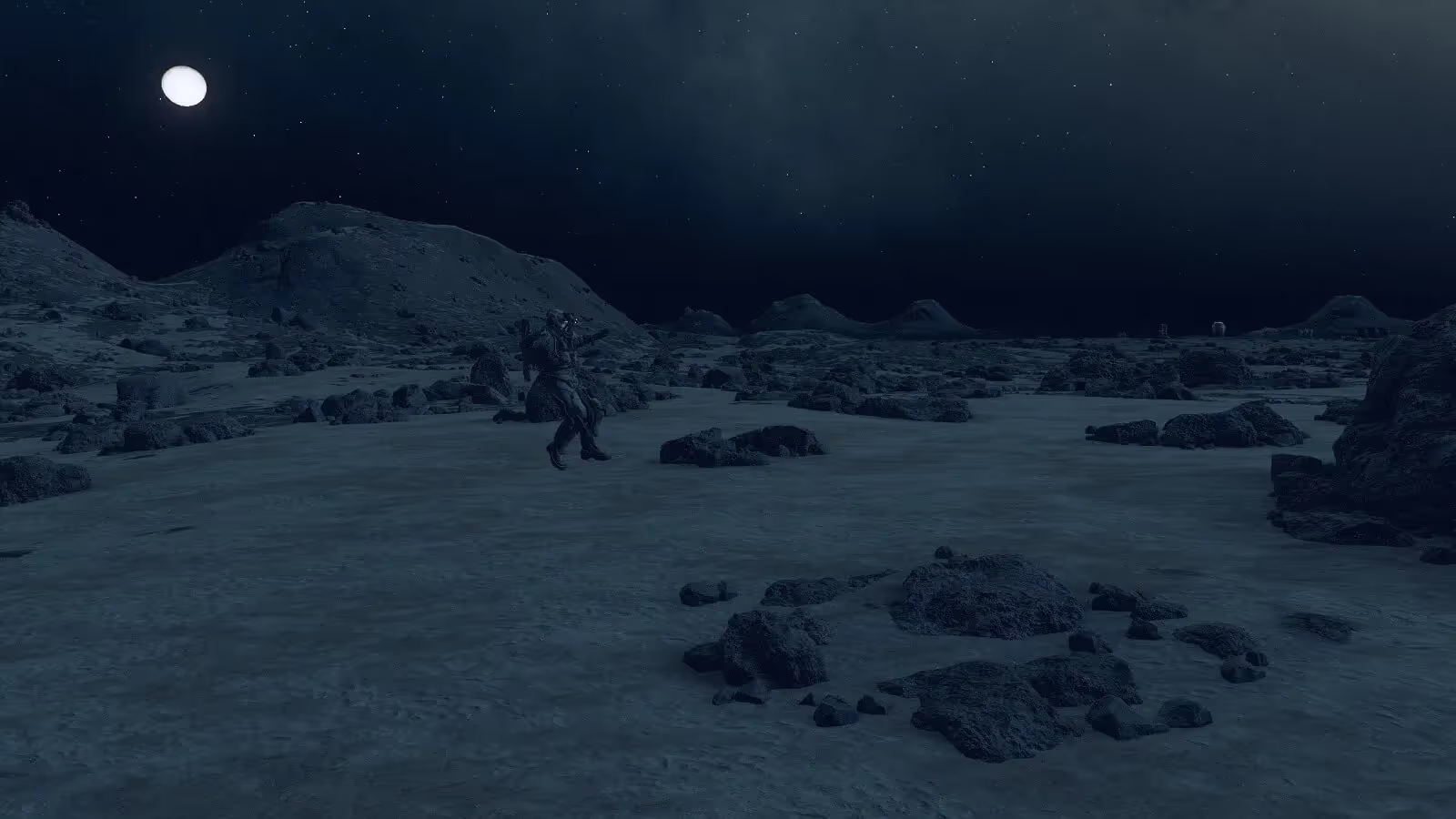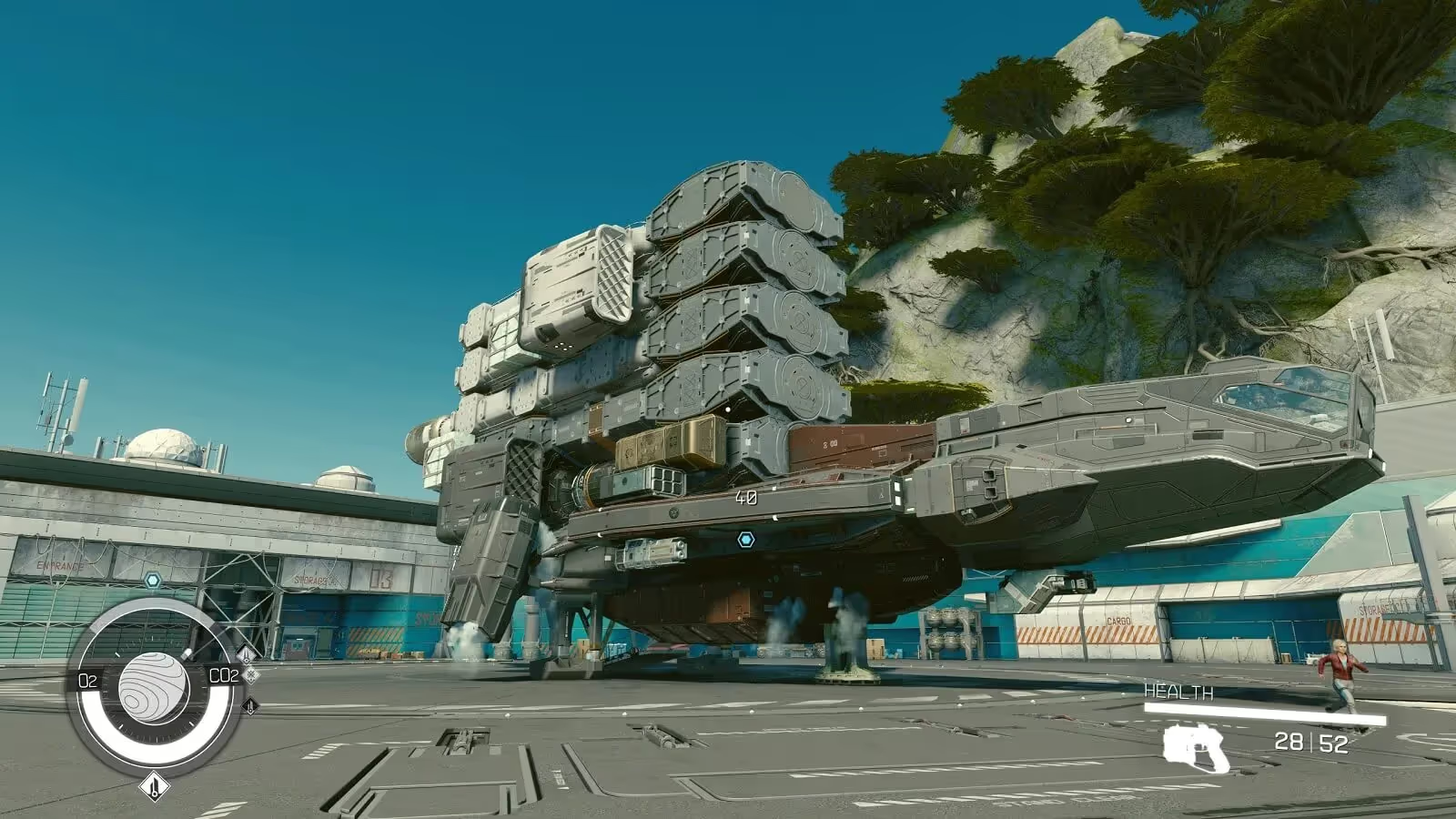PC
Xbox Series
Before we get into this review, I have something to confess: I, an objective games journalist, allowed myself to buy into Starfield’s hype, because even though I technically make money off being an unbiased writer, I live and breathe intelligent science fiction media. Interstellar is my favourite movie of all time, Mass Effect 2 is my favourite game, The Forever War is my favourite book, and Starship Troopers: Extermination is the title I’ve spent the most time playing as of late. The Firefly books inspired me to get back into reading, a flag from the losing side of The Unification War (still not convinced it was the wrong one) hangs over my gun safe that contains a real life version of Spike Spiegel’s Jericho 941 from Cowboy Bebop and a few weapons that wouldn’t be out of place in Jayne’s arsenal, and I’m even halfway through writing a book heavily inspired by Old Man’s War. I’ve been waiting for literal decades to play a good video game set in space, and while part of me wants to buy into the hate train that’s currently running over Starfield, the part of me that enjoys Ad Astras while staring up at the moon every night says to screw that, because Bethesda Game Studios’ latest and greatest title is the only video game I’ve played that actually fulfils all of its marketing promises. And that, plus everything else about the game, means it’s one of the best experiences on the market, and one that I will happily be playing in the same way I do Skyrim in a decade.
Ordinarily, I’d put a few disclaimers on that statement, but I honestly can’t think of any. The closest thing that Starfield has to a lacklustre element is its main story, which starts you off as a workaday miner on an extra-terrestrial world, but quickly throws you out into the the Settled Systems to find an assortment of space MacGuffins with the help of the Constellation group. This involves doing the same things that always need to be done in big budget open world RPGs, and more specifically the same tasks that needed to be completed in Skyrim and Fallout 4. Which is to say that to beat the game, you can expect to kill thousands of bandits, play politics with the world’s three main factions and spend more time inside of caves than a Minecraft player, all of which is done while attempting to figure out whether or not intelligent life actually exists outside of human colonies.

Although this premise is nothing new, especially for the roleplaying genre, what sets Starfield apart from previous Bethesda Game Studios titles is that it’s actually fun and interesting to play space detective, and not just after you’ve Stockholm Syndrome’d yourself into thinking that’s the case. The title’s main narrative does, to be fair, rely a bit too heavily on space magic and hand waving to make it worthy of a comparison to something like Firefly, but it has a story that’s well worth experiencing because the issues it explores are just as relevant today as they were when humans first looked up to the stars and wondered what the hell was up there. The characters who help answer the greatest question in the universe, which has two possible replies both of which are equally terrifying, are genuinely fantastic and consistently manage to defy the archetypes they clearly could’ve been. Without spoiling anything, the game also has a properly satisfying conclusion that encourages you to play it again in a unique take on New Game+, which given how important some of the decisions you can make throughout its 30-odd-hour-long main story’s runtime are, is well worth doing.
And truth be told, you’ll want to do that for non-narrative reasons too, because Starfield’s gameplay is actually pretty great. At its core, it’s a first/third-person shooter (which can be swapped between with the tap of a button) that also allows you to freely fly starships and build outposts on thousands of quasi-procedurally generated worlds, and all of these elements feel bloody fantastic. Starfield’s shooting isn’t quite as smooth as something like Call of Duty, and its piloting isn’t Microsoft Flight Simulator by any means, but it’s still best-in-class as far as games with worlds that take hundreds of hours to cross go. You can navigate its many planets without restriction from the get-go, build whatever weird ships you want provided you have the credits, and use its dozens of weapon types as soon as you find them. There’s an expansive set of skills to unlock, over a dozen companions to recruit and develop nuanced relationships with (à la Mass Effect), and a near-infinite amount of minerals to mine if that’s your thing, and all of these items look great and feel phenomenal to play with.
It’s worth noting that, technically, every time you want to travel to a new world, you will need to use a menu to do so. You can’t land on planets by simply travelling to them, and instead need to open an interface to do so, and each time you set foot on a foreign body, you can only walk for roughly thirty minutes in one direction before hitting an invisible wall that can be overcome by simply going back to your ship and choosing a new landing zone. This isn’t really a problem, seeing as ships move at a realistic speed and the planets you explore are bloody massive and almost always as unique as their real world inspirees, but it does make Starfield’s massive interpretation of the many galaxies in our universe feel a smidge more confined than they are in something like No Man’s Sky or Star Citizen.

However, even though that may be a dealbreaker for some, it’s one that’s worth ignoring because Starfield has an almost overabundance of side content, all of which is just as interesting if not more so than its main narrative. It, of course, has the almost obligatory military/rebel/thieves’ guild factions quests, with each one featuring a dozen hours of choice-heavy dialogue that’s superbly enjoyable to sit through and heavily references other science fiction media, but the game also has random quests that can be picked up while exploring, all of which capture the magic of the likes of The Expanse. Overhearing a conversation in Neon, the game’s Cyberpunk-inspired world, for example, can lead to you helping a gang of Saints Row 2-esque mobsters take out their much more evil rivals. Finding a random journal while raiding a bandit camp, too, can give you the location of a Star Wars-inspired ship complete with a dungeon and jet pack. There are hundreds if not thousands of adventures just like those two that can be found on Starfield’s near-infinite number of planets, which means that even after you’ve thought you’ve seen everything in the universe, there will always be one more quest marker to follow or NPC to talk with.
This, more than anything else in the game, embodies everything right with the genre, and is its main selling point. Over a decade ago, I often talked with my classmates about what they were doing in Skyrim in between maths lectures, and each one of them had some sort of unique tale to tell about how they’d found some cool weapon or encountered a unique NPC. It’s been almost a decade since I was in school, and I still haven’t found a reason to do that, but over the past few days on Discord, I’ve been chatting with my friends about the locations of various aliens, the most effective way to build a colony, and even just what kind of ships we were using, and every time I alt-tabbed, one of us would tell the story of some unique experience that inspired me to go on yet another trek across the galaxy even though I thought I’d seen everything Starfield had to offer just like I did when I was wearing short pants. And every time I did, I was shocked with the quality of the characters I encountered in the same way that seeing a new star in the real life sky makes you re-evaluate your life, which is something that no other non-Bethesda RPG, or Minecraft, can claim to do.
And this was only really possible because Starfield is a technical beast of a game. Regardless of the system you play it on, it’s a beautiful title with a mesmerising musical score heavily inspired by Interstellar and Fallout that has amazing animations that are almost as good as more narrative-driven titles. That goes without saying, though, but what doesn’t is that Starfield is, at least on the PC we played it on, almost bug free. In the 50-odd hours we spent exploring the stars while roleplaying as Ral Meynolds of the Firenity, we didn’t experience any major issues. The game ran at a solid 40-60FPS, only crashed to desktop three times, we never experienced any overly long loading screens, and the biggest error we dealt with was an NPC’s ragdoll occasionally clipping into the environment. For the first time since Nexus Mods became a thing, we don’t expect to have to download a community patch anytime soon, and also won’t be upgrading our CPU just to play the game, either, which is an accomplishment to say the least given the developer’s previous work and the current state of the AAA market.

Which, when combined with everything else about Starfield, means that not only is it the best game Bethesda Games Studios has ever made, but it is a testament to the power of properly made roleplaying titles. While its main narrative follows a familiar plot structure, and the lack of an ability to navigate the universe without using an in-game map is somewhat annoying, the game’s writing and gameplay more than make up for its almost non-existent shortcomings especially given its unique setting. In its best moments, Starfield is a video game adaptation of Firefly or one of John Scalzi’s novels, and in its worst, it’s a grossly engaging and massive roleplaying game with a staggering amount of well-made content. It tells a unique and hyper-relevant story with its second-to-none writing, its core gameplay is astoundingly smooth and fantastic, and there’s so much to do that even after a hundred hours, there will be entire star systems you haven’t so much as looked at. Starfield, which not only perfects almost every aspect of its genre but innovates them by taking place in both gaming’s and humanity’s final frontier, is what all open world video games should aspire to be, and for the first time in my career as a games journalist, I honestly can’t recommend a triple-A game enough. It’s almost entirely bug-free, has smooth shooting mechanics, and lets you roleplay as whatever science fiction protagonist you most identify with. What Bethesda Game Studios has done with Starfield is almost impossible, and that makes them mighty.
You can subscribe to Jump Chat Roll on your favourite podcast players including:
Let us know in the comments if you enjoyed this podcast, and if there are any topics you'd like to hear us tackle in future episodes!



